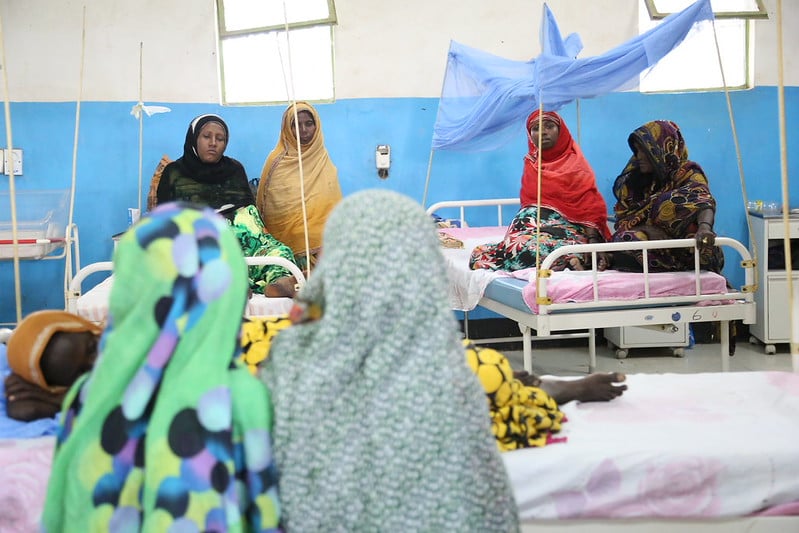Loneliness and isolation – the hidden threat to global health we can no longer ignore – World Health Organization (WHO)

Report on Social Disconnection as a Global Health Threat and its Implications for Sustainable Development Goals
Executive Summary
A comprehensive analysis reveals that social disconnection, encompassing loneliness and social isolation, constitutes a significant and escalating global health threat. Affecting approximately one in six individuals globally, this issue has profound negative consequences for health, well-being, and societal stability. The World Health Organization (WHO) Commission on Social Connection has identified this as a critical challenge, with evidence linking it to increased mortality rates equivalent to over 100 deaths per hour. This report outlines the direct impact of social disconnection on the achievement of the Sustainable Development Goals (SDGs) and presents a strategic framework for global action, as proposed by the WHO.
The Impact of Social Disconnection on Sustainable Development Goals (SDGs)
Social connection is a fundamental component of human well-being and is intrinsically linked to the success of the 2030 Agenda for Sustainable Development. The failure to address social disconnection directly undermines progress across multiple SDGs.
SDG 3: Good Health and Well-being
The most direct impact is on SDG 3. Irrefutable evidence demonstrates that social disconnection is a lethal risk factor for non-communicable diseases and mental health conditions. It significantly increases the risk of:
- Heart disease and stroke
- Depression and anxiety
- Dementia
- Premature death
Addressing social disconnection is therefore essential for achieving Target 3.4, which aims to reduce premature mortality from non-communicable diseases and promote mental health and well-being.
SDG 10: Reduced Inequalities
The burden of social disconnection is not distributed equally. It disproportionately affects vulnerable populations, thereby exacerbating existing inequalities, a core concern of SDG 10. Higher rates are observed among:
- Adolescents and young adults
- Individuals in low-income countries
- Older adults
Targeted interventions for these groups are crucial to ensure no one is left behind.
SDGs 4 & 8: Quality Education and Decent Work & Economic Growth
Social disconnection has tangible economic and developmental consequences, impeding progress on SDG 4 and SDG 8. The report links it to poor performance in both academic and professional settings. This results in reduced individual potential and imposes substantial economic costs on societies, estimated in the billions of dollars annually.
SDG 11 & 16: Sustainable Cities and Communities & Peace, Justice, and Strong Institutions
Social connection is the cornerstone of resilient and cohesive societies. It fosters the trust and social fabric necessary for community well-being (SDG 11) and national stability (SDG 16). Societies that cultivate strong social bonds are more innovative, secure, and better equipped to respond to crises, as highlighted by the COVID-19 pandemic.
Global Response and Strategic Framework
WHO Commission on Social Connection
In response to this global threat, the WHO has established the Commission on Social Connection. The Commission’s inaugural report, following the first World Health Assembly resolution on the topic, marks a turning point. It provides a clear, evidence-based path for governments and health systems to integrate social connection as a priority.
A Proposed Global Roadmap
The Commission proposes a global strategy built upon five key pillars to guide international and national efforts:
- Policy: Develop national policies that integrate social connection into health, education, and labor agendas.
- Research: Invest in research to understand effective, culturally relevant interventions.
- Interventions: Scale up cost-effective programs and support strategies.
- Measurement: Collect better data to track the prevalence of social disconnection and measure progress.
- Engagement: Build a global movement to raise awareness, change attitudes, and reduce the stigma associated with loneliness.
Proven Interventions and International Case Studies
The feasibility of tackling social disconnection is demonstrated by numerous successful initiatives worldwide. These interventions align with various SDGs by targeting specific community needs.
- South Africa: Peer-to-peer support programs for low-income older people (Addresses SDG 1, 3, 10).
- Republic of Korea: “Social prescribing” of activities like gardening and music for older adults (Addresses SDG 3, 11).
- Djibouti: Integration of social connection into broader development policy (Addresses SDG 17).
- Spain & Albania: Embedding social connection into mental health and ageing policies, respectively (Addresses SDG 3).
- Denmark, Germany, Japan, Finland, Netherlands, Sweden: Establishment of dedicated national strategies to combat loneliness.
- Australia, Great Britain, USA: Public campaigns encouraging small acts of kindness to strengthen community bonds (Addresses SDG 11).
Conclusion and Recommendations
Social health is not a luxury but a fundamental human need and a prerequisite for sustainable development. The failure to act carries severe consequences in terms of public health, economic prosperity, and social cohesion. It is imperative that leaders at all levels recognize social connection as a political priority.
The report calls for bold, collaborative, and large-scale action. By implementing the five-pillar strategy and scaling up proven interventions, the global community can reverse the trend of social disconnection, thereby building healthier, more resilient societies and advancing the 2030 Agenda for Sustainable Development.
Relevant Sustainable Development Goals (SDGs)
SDG 3: Good Health and Well-being
- The article’s central theme is that social disconnection is a “serious global health threat” and an “overlooked danger to health and well-being.” It directly links loneliness and social isolation to increased risks of physical diseases like “heart disease, stroke,” mental health conditions such as “depression, anxiety, dementia,” and “premature death.” The call to make social health a “political priority” and integrate it into health systems firmly connects the issue to SDG 3.
SDG 10: Reduced Inequalities
- The article highlights that the burden of social disconnection is not evenly distributed. It states that among “adolescents and young adults, as well as people living in low-income countries, the rate is even higher.” It also mentions specific interventions for “low-income older people in South Africa” and “older adults in the Republic of Korea,” pointing to age and economic status as factors of inequality in social connection. This aligns with the goal of promoting social inclusion for all, irrespective of age or economic status.
SDG 8: Decent Work and Economic Growth
- The economic impact of social disconnection is explicitly mentioned. The article states that it “can also result in poor school and work performance, and costs economies and societies billions per year.” The call to integrate social connection into “labor agendas” suggests that improving social well-being is crucial for productive employment and overall economic prosperity.
SDG 11: Sustainable Cities and Communities
- The article discusses the impact of social disconnection on communities, noting that it is “fraying the fabric of our communities.” Conversely, it argues that fostering connection is a “cornerstone of… social cohesion” and that “societies that foster trust and connection are more innovative, more secure and better able to respond to crises.” This directly relates to building inclusive, resilient, and sustainable communities.
SDG 17: Partnerships for the Goals
- The article is a call for global, collaborative action. The creation of the “WHO Commission on Social Connection” itself represents a multi-stakeholder partnership. The text calls on “all countries to prioritize social connection” and proposes a “global roadmap” and the building of a “global movement,” which embodies the spirit of partnership required to achieve the SDGs.
Specific SDG Targets
SDG 3: Good Health and Well-being
- Target 3.4: By 2030, reduce by one third premature mortality from non-communicable diseases through prevention and treatment and promote mental health and well-being.
- The article directly supports this target by identifying social disconnection as a key risk factor for non-communicable diseases (“heart disease, stroke”) and poor mental health (“depression, anxiety”). The proposed interventions, such as community programmes and “social prescribing,” are forms of prevention and promotion of well-being.
SDG 10: Reduced Inequalities
- Target 10.2: By 2030, empower and promote the social, economic and political inclusion of all, irrespective of age, sex, disability, race, ethnicity, origin, religion or economic or other status.
- The article’s focus on the higher rates of loneliness among specific groups (youth, elderly, people in low-income countries) and the call to address social isolation directly aligns with promoting social inclusion for these vulnerable populations.
SDG 8: Decent Work and Economic Growth
- Target 8.5: By 2030, achieve full and productive employment and decent work for all women and men, including for young people and persons with disabilities, and equal pay for work of equal value.
- By stating that social disconnection leads to “poor… work performance,” the article implies that addressing it can improve productivity. The call to integrate social connection into “labor agendas” aims to create better work environments, contributing to the goal of productive employment.
SDG 17: Partnerships for the Goals
- Target 17.18: By 2020, enhance capacity-building support to developing countries… to increase significantly the availability of high-quality, timely and reliable data disaggregated by… income, age… and other characteristics relevant in national contexts.
- The WHO Commission’s call to “collect better data to track the problem and measure progress” directly corresponds to this target. The article’s own data points (“nearly one in six people globally report feeling lonely,” with higher rates for youth and in low-income countries) demonstrate the need for such disaggregated data.
Indicators for Measuring Progress
Explicit and Implied Indicators
- Prevalence of loneliness: The article explicitly states, “nearly one in six people globally report feeling lonely.” This is a direct indicator that can be tracked over time to measure progress. The article also implies this data should be disaggregated by age and income level.
- Mortality from non-communicable diseases: The article links loneliness to “871,000 deaths annually” and an increased risk of “heart disease, stroke… and premature death.” A reduction in mortality rates from these specific conditions could serve as an indirect indicator of improved social health.
- Prevalence of mental health conditions: The connection made to “depression, anxiety, dementia” implies that tracking the incidence of these conditions is a way to measure the impact of social disconnection.
- Economic cost: The statement that social disconnection “costs economies and societies billions per year” suggests that this economic burden can be quantified and tracked as an indicator of the scale of the problem.
- Existence of national policies: The call for countries to “develop national policies that integrate social connection” and the mention of countries like Denmark, Germany, and Japan that have “dedicated national strategies” imply that the number of countries with such policies is a key progress indicator.
Summary of SDGs, Targets, and Indicators
| SDGs | Targets | Indicators (Mentioned or Implied in Article) |
|---|---|---|
| SDG 3: Good Health and Well-being | Target 3.4: Reduce premature mortality from NCDs and promote mental health and well-being. |
|
| SDG 10: Reduced Inequalities | Target 10.2: Promote social, economic, and political inclusion of all. |
|
| SDG 8: Decent Work and Economic Growth | Target 8.5: Achieve full and productive employment and decent work for all. |
|
| SDG 11: Sustainable Cities and Communities | (Implied) Target 11.7: Provide universal access to safe, inclusive and accessible, green and public spaces. |
|
| SDG 17: Partnerships for the Goals | Target 17.18: Enhance capacity-building for data collection in developing countries. |
|
Source: who.int

What is Your Reaction?
 Like
0
Like
0
 Dislike
0
Dislike
0
 Love
0
Love
0
 Funny
0
Funny
0
 Angry
0
Angry
0
 Sad
0
Sad
0
 Wow
0
Wow
0




































![Lancaster homeowner’s energy-efficient renovation sparks clash over historic preservation [Lancaster Watchdog] – LancasterOnline](https://bloximages.newyork1.vip.townnews.com/lancasteronline.com/content/tncms/assets/v3/editorial/9/ed/9ed03d32-c902-44d2-a461-78ad888eec38/69050b156baeb.image.png?resize=150,75#)










































